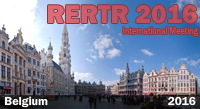Abstracts and Available Papers Presented at the
2002 International RERTR Meeting
NEUTRONIC PERFORMANCE OF SEVERAL LEU FUEL ASSEMBLY DESIGNS FOR THE WWR-SM RESEARCH REACTOR IN UZBEKISTAN
M. M. Bretscher, N. A. Hanan, and J. E. Matos
RERTR Program
Technology
Development Division
Argonne National
Laboratory
Argonne, Illinois
60439-4815 USA
and
B. S. Yuldashev, S. Baytelesov, and A. Rakhmanov
Institute of Nuclear
Physics
Tashkent, Uzbekistan
ABSTRACT
The 10 MW WWR-SM research reactor in Uzbekistan currently uses HEU (36%) IRT-3M 6-tube fuel assemblies manufactured by the Novosibirsk Chemical Concentrates Plant in Russia. Recent 4x4 core configurations reflected by beryllium have been operated at 8 MW. The Institute of Nuclear Physics plans to convert the reactor to LEU (19.7%) fuel as soon as a suitable LEU fuel assembly is qualified. This study compares the neutronic performance of the reactor and its experiments using LEU pin-type and LEU tube-type fuel assembly designs with the current HEU (36%) reference fuel assembly.
Both 3D Monte Carlo and 3D diffusion theory calculations were performed to analyze a critical core configuration with partially-burned HEU fuel assemblies in order to establish the credibility of the analytical methods and computer models used to describe the reactor and its experiments. Results based on these techniques are in reasonable agreement with the measured data.
An LEU pin-type design (164 pins, 4.5 g U/cm3, 375g 235U) or an LEU tube-type design (IRT-3M, 6-tube, 5.4 gU/cm3, and 364g 235U) with U9Mo-Al fuel meat could operate with about the same cycle length and experiment load as the reference HEU (36%) IRT-3M fuel. The annual fuel assembly consumption would be nearly the same in these HEU and LEU cores. For the LEU pin-type design, fast (thermal) fluxes would be reduced by 2.5% (14%) for experiments located at the center of the fuel assemblies and by 0.5% (4%) for experiments located in experiment channels in the beryllium reflector. For the LEU tube-type design, fast (thermal) fluxes would be reduced by 3.5% (15%) for experiments located at the center of the fuel assemblies and by 1.2% (5%) for experiments located in experiment channels in the beryllium reflector.
If the 235U content of the LEU pin-type fuel assemblies were increased to 480g (using pins similar to those planned to be tested in the WWR-M reactor at Gatchina, Russia in 2003 and 2004), the annual consumption of fuel assemblies would be reduced by about 35%. Fast (thermal) fluxes would decrease by about 3.5% (27%) in the experiment positions in the core and by about 1.5% (8%) in the experiment positions in the beryllium reflector. However, for this 4x4 core configuration the LEU IRT-4M 6-tube fuel assemblies with UO2-Al fuel meat, ~3 gU/cm3, and 265g 235U would increase the annual fuel assembly consumption by over 300%.
![]() PDF version available
PDF version available
DOWNLOAD full paper in PDF format.
Contact:
Dr. Nelson
Hanan
Nuclear Engineer
Argonne National Laboratory
9700 South Cass Avenue
Argonne, IL 60439 USA
Phone: (630) 252-6627
Fax: (630) 252-5161
![]()




